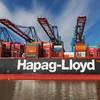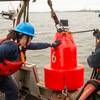The North American high speed ferry market has been slow to develop compared with other areas such as Australia, Europe and the Far East. However, recent developments show the U.S. market is gathering momentum - not only in respect of the number of orders, but also with regard to the speed and sophistication of the ferry designs. This trend was emphasized when, in September 1997, one of the world's largest high speed ferry operators, Buquebus, placed a contract with Derecktor Shipyards in Mamaroneck, N.Y. for a high specification, 300 passenger ferry with a maximum speed of more than 50 knots.
The specification for the ferry required a maximum contract speed of over 50 knots and a high level of seakeeping and passenger comfort. For design, Derecktor Shipyards selected Naval Architects, Nigel Gee and Associates Ltd, with whom they had previously teamed for construction of 124.7 ft. high speed catamarans for New York Fast Ferry.
The ferry was to be constructed for operation on a route between Fort Meyers, Fla. and Key West or, alternatively, on a route across the river Platte between Buenos Aires, Argentina and Montevideo in Uruguay as shown in Figures 2 and 3.
Passenger accommodation was provided for a total of 300 passengers, with approximately 250 in a spacious main deck saloon, and 50 passengers in an upper deck first class lounge, as shown in Figure 1. The high speed requirement led to the selection of gas turbine engines using a Detroit Diesel TF80 propulsion system powering MJP waterjets.
Construction of the vessel began in November 1997 with successful completion of sea trials in October 1998, surpassing all contract requirements.
Optimization of hull form parameters for any vessel requires careful consideration of many influencing factors such as calm water performance, seakeeping, production costs and volume requirements for machinery etc. However, calm water resistance is commonly the dominating factor, often at the expense of the vessel's seakeeping, and the good design is the one which manages to balance these two important characteristics.
During the initial stage of the design, NGA completed a parametric study to establish the preliminary dimensions for the catamaran hulls. NGA's early design work led to the selection of a "higher lift" warped chine hull design. The total resistance of this hull form became more favorable, compared to round bilge hull forms commonly used on 30-40 knot designs of the same length.
The hull and superstructure are of lightweight aluminium construction designed and built to meet the requirements of the American Bureau of Shipping Regulations for the Classification of High Speed Craft. The construction uses 5083-H321 plate, 6061-T6 extrusions and extruded "T-Bar" planking for decks, superstructure, bulkheads and other flat areas of the structure. The typical structural style is shown in Figure 3. All plate was CNC-cut to reduce production time.
Bottom structure in way of waterjets and machinery is an area that has suffered from failures on many other high speed ferries. To ensure reliability of not only the aluminium structure in this area, but also the FRP waterjet intake ducts, a structural analysis using a finite element model (see Figure 10) of the engine room structure was completed by CETEC Consultancy Ltd which included the skin, frames, girders, ducts and - where appropriate - machinery.
The finite element model was also used to reduce the weight and cost of the power transmission. The initial design incorporated a support bearing on the forward end of the waterjet shaft to prevent overloading of gearbox bearings. Using the model to confirm the deflection envelope between the waterjet at transom and the gearbox output flange under any operating condition, allowed the forward shaft bearing and support structure to be deleted, with a valuable weight saving.
Gas turbine propulsion was preferred and the Detroit Diesel TF80 Marine Turbine was selected. The Detroit Diesel system uses a Cincinnati MA107 gearbox and two AlliedSignal TF40 marine gas turbines, with a total power of 7,420 hp in each hull.
For propulsion, Bird Johnson type MJP 950 DD waterjets were selected. This waterjet design was a transitional model between the existing range and a new generation of high efficiency waterjets with improved cavitation performance. To improve waterjet performance the waterjet intake geometry was developed by MJP using 3-D CFD analysis of the flow inside the intake and flow across the bottom surface of the hull using incompressible, three dimensional flow calculation software. NGA/Derecktor had previously used FRP waterjet intakes on the NYFF ferries and to save weight and provide the highest quality surface on the waterjet intake duct, this approach was also adopted on the Buquebus ferry.
The machinery configuration and arrangement of the combustion air intake and exhaust is shown in Figure 4.
To improve seakeeping, a Ride Control system from Maritime Dynamics Inc was fitted. This system incorporates an active bow T-foil and stern trim tab on each hull to provide motion damping forces on each corner of the vessel.
Through the construction of the 147.6 ft. ferry for Buquebus there were three major points to be achieved:
1) Achieve a high speed requirement. This implies building within weight budgets.
2) Deliver on time.
3) Deliver a high quality product.
The weight of the vessel and fairness of the hull lines are critical to obtaining the specified speed.
For the weight, Derecktor monitored all components through the engineering and purchasing departments, and investigated many different parts/materials to meet the overall weight target.
Reducing weight usually costs money but this can be cost effective if labor hours are reduced. Fire insulation is a good example of this. The standard material used in the U.S. is Rock Wool. To achieve an A60 rating with Rock Wool on aluminum requires four in. of material. Using a ceramic fiber insulation it is possible to reduce this to two in. Although the product is more expensive, there is a significant weight saving, and an added saving on installation time.
Encouraged by the success of the composite water jet intakes on the two New York Fast Ferries, Derecktor incorporated this construction method into the Buquebus vessel. The two ferries had run for a cumulative four years in New York harbor without any damage from floating debris or cavitation to the inside of the tunnels.
On-time delivery is very important to customers. To expedite production, Derecktor made extensive use of the Internet to move the engineering files around the world. The exterior styling of the boat was from Italy, the engineering from England, the lofting and nest tapes from Seattle, the cutting in Florida and the construction in New York. The interior was designed in Uruguay and fabricated in Southampton, England.
Each of these activities had to be approved by the yard, and the Internet was the only way to move the files around the world quickly and not hold up production because of lack of information.
Sea trials began in early October 1998. Unfortunately, there is still no way of controlling the elements and, as is often the way, weather conditions were far from ideal for speed trials on a vessel of this size with 15-18 knots of wind and a two to three ft. sea throughout the trials period.
Power was confirmed from calibrated torque measurements taken on the waterjet input shaft. A maximum full load speed of 52 knots was achieved, although this was not at full power, due to some early problems with the turbine fuel system. Another problem encountered during sea trials was recirculation of turbine exhaust gases into the combustion air inlet, which can lead to a decrease in power and increased maintenance due to contamination of the turbine blades. This problem was quickly cured by adding deflector plates and side air inlets to locally increase air flow in way of the combustion air inlets.
Extrapolating to maximum power gave a fully loaded speed of 53 knots. During lighter weight trials with 12 tons of deadweight, the vessel achieved a speed in excess of 55 knots.
Speed trials on two-engine operation (i.e. one TF40 turbine on each side shut down) were also completed, with the vessel achieving a maximum speed of 40 knots.
Sound measurement trials were completed with noise measurements taken by noise consultants, J & A Enterprises Inc, at various locations throughout the vessel with the microphone held at approximately five ft. above sole. At an early stage in the design, NGA and Derecktor decided to pursue a philosophy of not fitting any sound insulation, other than the inherent sound deadening provided by fire insulation, until noise measurements could be completed during trials.
This simple approach allows for noise reduction to be applied exactly where it is required, with a potential saving in the weight of additional noise insulation which may not have been effective. Average noise levels within the lower and upper passenger saloons during initial trials were 82 db(a) and 76 db(a) respectively. This trial also showed noise generated from the hull bottom with the vessel at high speed (115 db(a) in forward voids) was contributing significantly to the interior noise levels.
Therefore, following this trial, two forms of noise reduction were installed. Firstly, polymer panels were applied to areas of the bottom structure to provide mass damping of these panels and secondly, a layer of sandwich construction insulation with a high density middle layer was applied across the underside of the deck in way of the passenger saloon.
The combined effect of these treatments was to reduce the average noise level in the lower deck passenger saloon to 75 db(a) and to 72 db(a) in the upper deck saloon.
Patricia Olivia II is the first ferry of its type to offer a fully loaded service speed in excess of 50 knots. However, there is an increasing requirement for even higher speeds and to meet this need, NGA are currently working on a modified design of the NGA45m using 2 x Detroit Diesel TF100 Marine Turbine Systems to give fully loaded speeds close to 60 knots.
In addition to the current growth in larger high speed passenger/car ferries there is a high level of interest in 300 to 500 passenger ferries with very high operating speeds. Design and tank testing has already been completed by NGA for a 70 knot Pentamaran high speed passenger ferry, and it is likely vessels with this order of speed will be in service in the year 2000.
Looking further ahead, it is felt the 100 knot ferry will be realized in the next decade and the challenge to industry will be to design and regulate these ultra fast vessels to ensure passenger safety.
John Bonafoux is a founding partner in Nigel Gee and Associates in 1986 and has since been technical director of the company. Gavin Higgins is chief engineer of R E Derecktor in Mamaroneck, N.Y. where he has been responsible for the construction of sail and motor yachts. In 1997, he became the general manager of R E Derecktor.
Excerpted from a presentation given at the 15th Fast Ferry International Conference, Boston, Mass., February 16-18, 1999.
Sponsored Content
LR - Fit for 55: Managing compliance and optimising operations

Use Roxtec seals, services and software

Subscribe for
Maritime Reporter E-News
Maritime Reporter E-News is the maritime industry's largest circulation and most authoritative ENews Service, delivered to your Email five times per week









